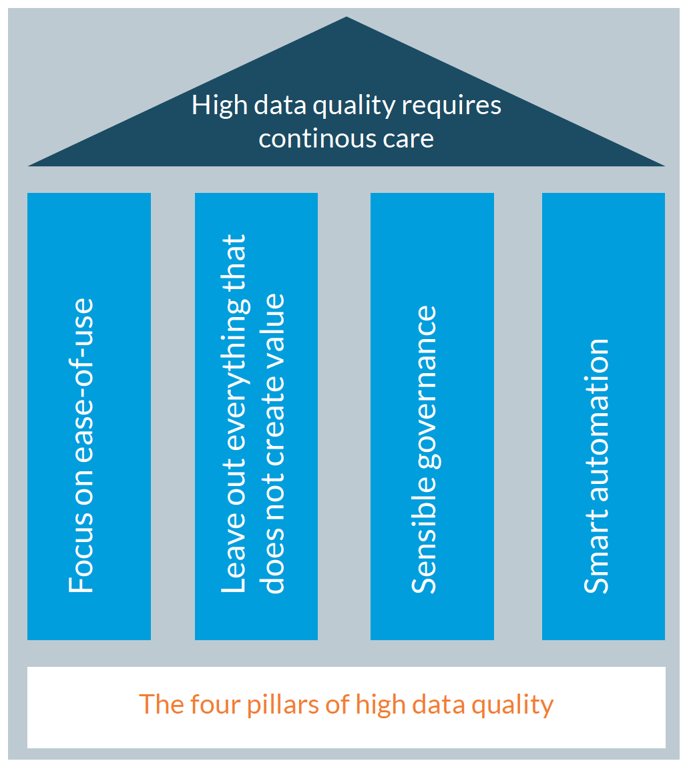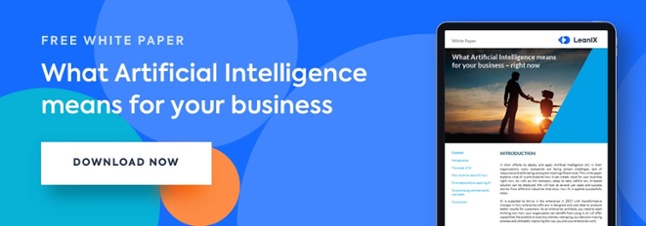
In a previous post, we highlighted the current state of AI and explored ways to utilize AI to improve business processes. This second installment will cover the steps needed to prepare your company for AI.
FIRST STEPS BEFORE APPLYING AI
With so many types of AI technologies, it can be difficult to figure out what is the best way to jump in when it comes to introducing AI into your organization. From the simpler cognitive technologies like an extension of traditional analytics, to the more complex ones such as deep learning networks and algorithms, individuals who are new to this may feel overwhelmed by the process of starting out. Below are the first steps to follow in the process of AI implementation:
1. Get a grip on data
In a company, AI is an “enhancer” that depends on certain factors. Before any AI-based solutions can be effectively set up, all issues with data quality, ERP and business process improvement need to be addressed first.
The first step is to understand the most fundamental element for all AI technologies - data. Companies collect massive amounts of data, while decision makers have little ability to get insights from most of it. Data is useless without effective machines in place to transform it into something of value. That’s the role that machine learning is starting to play. Today’s systems can not only take in billions of data points and analyze them in minutes, they can also learn from the data and get better in time.
Apart from that, structured data (which is captured and stored in a database) represents only a small part of existing information. In reality, it has been estimated that 80% of digital data is unstructured.
More importantly, the quality of data leaves a lot to be desired. The key reasons for that are poor data definitions, inconsistent and sub-optimized business processes, and under-utilized core business applications like enterprise resource planning (ERP).
At the end of the day, data accuracy, completeness, relevance, consistency, reliability and accessibility are a big challenge for any organization.
Data Quality

Figure 1: The four pillars of high data quality
To maintain a high level of data quality, an organization must focus on four key components:
Ease-of-use
This means that usability is mandatory for any data capturing tool. The easier to use it, the more people will embrace it in their daily work. This requires formulating and constantly improving certain KPIs based on: time needed for a new user to be comfortable using the tool, the amount of documentation required, and time needed to execute basic transactions.
Leave out everything that does not create value
Data initiatives often collect any information that might possibly help them in the future. Having a satisfying answer for anyone who would question the need of a data record is crucial. This way, people will maintain the data record instead of simply dropping it.
Sensible governance
Governance is mandatory for having clear conventions established on which data to enter or the defined milestones to enter data, e.g. project gateways or definition of done in Scrum. Likewise, a lean quality management system, supported by an Enterprise Architecture platform helps the “gardeners” of the data to keep it regularly up-to-date.
Smart automation
Data available within companies ranges from business data, e.g. customer or product data, to project information and, particularly, operational information, such as tools used for development or operating, e.g. Docker.
Real-time data
AI technologies demand businesses to be “real-time”, i.e. have the ability to perform transactions and run analytics at the same time. The Internet of Things (IoT) is increasing the urgency for enterprises to embrace real-time streaming analytics. Predictive analytics are based on AI technologies and are the core of these solutions. A survey by Narrative Science, a natural language-based analytics provider, revealed that many enterprises are taking advantage of machine learning and AI capabilities, but do not necessarily know it.
Only 38% reported using those capabilities to automate routine tasks, yet 88% said they used analytic tools that incorporated predictive analytics, automated written reporting and communications, and voice recognition and response. LeanIX provides companies an easy framework to apply real-time data for the right context. The LeanIX Metrics Add-on allows to capture and analyze time-series data in the context of Enterprise Architecture, e.g. applications.
2. The key role of ERP systems
Upgrading or re-implementing core ERP systems is a business need. Companies must get ready for the AI transformation of ERP solutions by fixing their IT strategies and realizing the value of the AI and ERP integration. AI-based ERP solutions will impact the center of daily operations, like taking over humanly performed routine tasks in the end-to-end business process model – a change driven by a constant need to reduce operational costs.
While ERP solutions evolved over the last two decades, companies still have a hard time converting data into important information, decisions and actions - a challenge that continued to be present over the past five years through the growth of unstructured data, captured without a clear strategy of using it right.
The tools to fix this situation are available and consist of a range of established solutions and technologies that include:
- ERP solutions that allow organizations to run cost-efficient and effective operations.
- Big data solutions to manage structured and unstructured data.
- Business analytics and Enterprise Architecture solutions to provide information with a user-friendly experience.
- Computing power that allows enterprise solutions to manage large data sets and complex algorithms.
- Internet of Things (IoT) technology to capture real-time performance information.
- In-memory database technologies to explore large data sets in real-time.
The major ERP software providers offer solutions that process transaction in-memory, making transactional data instantly accessible for analytics and subsequent transactions.The two most common areas where AI is integrated with ERPs today, are customer service and maintenance management.
3. Preparing your business processes
The third key component for AI solutions is the consistent use of a simple, standardized and harmonized set of business processes, which is a challenge in itself.
Companies struggle to optimize their business processes because of a siloed behavior of functional disciplines, lines of businesses, and operating units. This requires a cross-functional integration to optimize business processes to an outstanding level, while many organizations are optimizing their verticals.
In a business scenario like the Accounts Payable (AP) process, for example, AI can be used in the form of supervised machine learning to scan invoices while a human indexer initially ‘teaches’ the tool where to find important data in a simple point-and-click fashion, such as an invoice number, gross amount, etc. The tool then recognizes certain patterns and, after a handful of invoice examples per supplier, is able to find the respective data on its own, even if fields have moved on a page or the total amount moves to the next pages.
After a brief training period, the AI-enabled tool can perform the data extraction completely on its own. It only brings invoices to human attention in case it is not confident enough, be it for new suppliers, bad scan quality, hand-written content, etc. These issues can be directly corrected in the tool and the indexing team changes their role to that of a pure supervisor, saving a lot of time per invoice.
The tool is able to perform its recognition within seconds, even in case of required supervision, and it triggers a quick help request to its human colleague, as an exception from the regular fully automated process.
For now, the right solution for most business scenarios is a hybrid one: use automation and AI where it can be used best, like high volume, low creativity tasks, and add as much human power as required to deliver the most efficient yet flexible process that we can.
This means that identifying areas where combining humans and their specific expertise together with the artificial workforce, based on proper requirements gathering, can leverage the best results.
Automation should have a positive effect on workers whose repetitive tasks are taken over by machines. They will have gained a wealth of experience to perform higher value tasks with the technology freeing up time. This will improve their job satisfaction and positively impact the client experience.


/EN/Reports/Thumbnail-Obsolescence-Gartner.png?width=140&height=100&name=Thumbnail-Obsolescence-Gartner.png)
/EN/White-Paper/EN-IDC-Inforbrief-Application-Rationalization-Portfolio-Management-Thumbnail_v2.png?width=140&height=99&name=EN-IDC-Inforbrief-Application-Rationalization-Portfolio-Management-Thumbnail_v2.png)
